Our second walking tour of Provo started on the east side of University Avenue and took us down the other half of Center Street. We explored a few more commercial buildings, historic houses, churches and schools and learned about some of Provo's most prominent early residents.
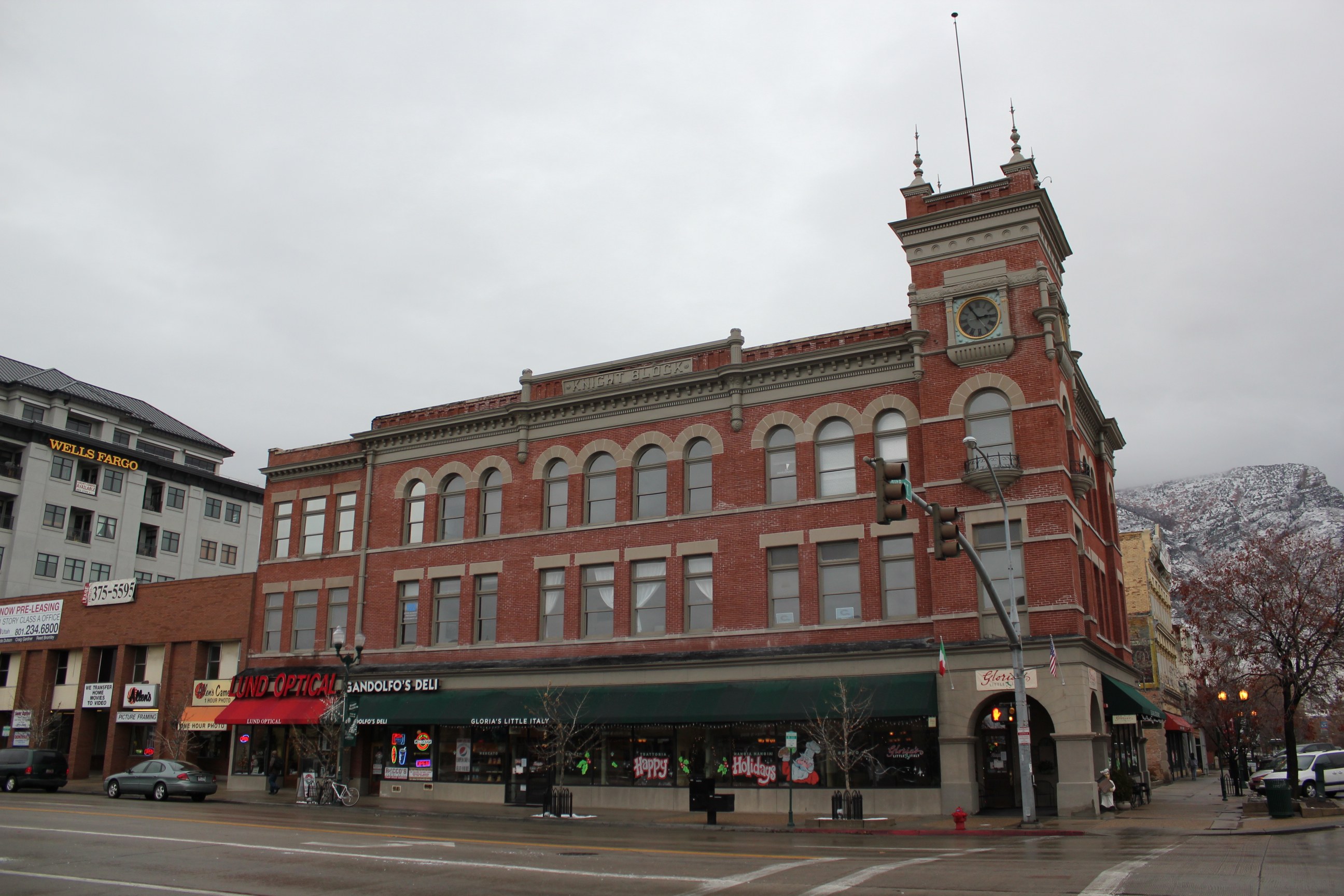 |
| Knight Building, present day |
Knight Building
(Corner of University Avenue and East Center Street)
- constructed in 1900 and served as Jesse Knight’s financial center
- 3 story building of red brick and gray limestone lintels; clocktower
- This 9,000 square foot Victorian Romanesque style building was built by mine owner/entrepreneur Jesse Knight by Richard C. Watkins
- Jesse Knight was born in 1845 in Nauvoo, Illinois (6th child of Newel Knight, a close friend of Joseph Smith’s and his second wife, Lydia; Newel died in Nebraska).
- Jessie’s family migrated west, and reached Utah in 1857.
- Twelve years later Jessie married a woman by the name of Amanda McEwan, and began a ranch in Payson, Utah. Following an impression that he had, Jessie began a mining operation in the Eureka area (Tintic Mining Industry) and became rich. He subsequently bought other mines, founded a bank, purchased real estate in Provo, bought the Provo Woolen Mills, and started farming and cattle interests in Canada.
- The primary focus of his 65 companies was copper, iron, and coal mining, with gold, silver, and other precious metals as secondary products.
- Knight was known by the moniker "Uncle Jesse" during his lifetime due to his image as rich but giving uncle. In his writing, he expressed a belief that his money was for the purpose of doing good and building up his church; he regarded the matter as a "trusted stewardship."
- Jessie Knight died in 1921, designating much of his amassed fortune to BYU and various other institutions.
- Although he strayed from the LDS Church in his early years and briefly affiliated with the anti-Mormon Liberal Party in Utah, he was a devout member for most of his life and helped to save the LDS Church from financial ruin incurred from legal battles with the federal government over control of the Utah territory and issues such as polygamy.
| A group of riders on horseback, c. 1880-1920; the Gates-Snow Building can be seen in the background with its large advertisement for 5 cent cigars |
Gates-Snow Building
41 East Center Street
- In 1889 the Snow Brothers expanded their store and moved from the first floor the Academy boarding house to the old Factory store across the street from the courthouse. They added a story to the building. The next year Snow added J. F. Gates as a partner.
- The new company tore down the existing building and completed a three story building.
- The business’ success did not last. In 1890 a depression hit Provo, Utah, and the rest of the United States. The impressive building was completed in October 1890. By April 1891 the store was going out of business.
- In 1898 Jesse Knight purchased the building for $3,600.
- In 1902 Gates and Snow dissolved their furniture partnership, and M. Snow continued to sell furniture. Gates and Snow continued to operate an insurance business.
 |
| Knight Mansion, c.1906 |
Jesse Knight House/Knight Mansion/Berg Mortuary
185 East Center Street
- built in 1905 by architect Ware Walter
- Late Victorian/Colonial Revival
- Two and a half stories tall, the Jesse Knight home was built in the Colonial Revival Style. Possessing a symmetrical facade, the detailing of the home exhibits “A broad entablature with a boxed cornice with egg and dart ornament and dentils on the frieze, swan’s neck pedimented dormers, Ionic capitals on quoins that are meant to resemble pilasters, pilasters on the corners of the dormers and flanking the first floor windows, and the Ionic columns (Utah State Historical Society p. 2).”
- Berg Mortuary was established in 1870 by Ole H. Berg and his son, Wyman. In the beginning they occupied a smaller facility at 40 East Center Street. In 1935 they purchased the Jesse Knight mansion at 185 East Center Street and moved their business to that location.
 |
| Present-day Berg Mortuary |
J. Albert Scorup House
237 East Center
- Built in 1887 for LDS General Authority Erastus Snow.
- Early Victorian with some elements of Greek Revival
- Since 1917, the property has been owned by J. Albert Scorup and his descendants
 |
| J. William Knight House, c. 1940s |
J. William Knight House
289 East Center Street
289 East Center Street
- 1910; Italianate or Box Style with Prairie Style influences
- built for J. William Knight and his wife Lucy Jane Brimhall and remained in the Knight family until 1945
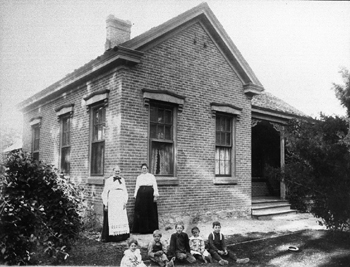 |
| Hannah Smith (in white apron) and family members in front of her house |
Hannah Smith House
315 East Center Street
315 East Center Street
- built in 1878 for one of George A. Smith’s wives (Hannah, #6)
- When Smith died, only the foundation had been completed
- Hannah raised her children here and her grandson, George Albert Smith (a prophet) spent a lot of time here
- remarkable original condition and simple architecture style; vernacular architecture
Knight-Mangum House
381 East Center Street
- completed in 1908.
- It was built for Mr. W. Lester Mangum and his wife Jennie Knight Mangum. Mrs. Mangum was the daughter of the famous Utah mining man, Jessie Knight. The lot was purchased for $3,500 and the home was built at a cost of about $40,000. [almost $1M today] The Mangum family was able to afford the home due to the fact that they had sold their shares in Jessie Knight's mine located in Tintic, Utah, for eight dollars a share. They had purchased the shares for only twenty cents a share, so the excess allowed them enough funds to purchase the home."
- After the death of Mr. Mangum in 1949, the home was sold to Paul Salisbury of Salt Lake City who divided the home up into eleven individual apartments.
- This two and one half story house in a style which is the product of the Arts and Crafts movement has an asymmetrical composition, steep gable roof with exposed rafters, decorative stick work on the top two stories, cross gables and gable dormers, exposed purlins, decorative brackets along the roofline, and a flat roofed single story porch with exposed rafters that wrap around the southeast corner. The house rests on a raised concrete basement.
- Clinker brick has been used for the first story, for the posts of the porch, for the chimneys, and for the wall that surrounds the house.
- In early brick firing kilns, the surface of the bricks that were too close to the fire changed into the volcanic textures and darker/purplish colors. They were often discarded, but around 1900, these bricks were discovered by architects to be usable, distinctive and charming in architectural detailing, adding the earthy quality favored by Arts & Crafts style designers. Modern brick-making techniques can recreate the appearance of these bricks and produce a more consistent product.
 |
| Knight-Allen House, present day |
Knight-Allen House
390 East Center
390 East Center
- The Knight-Allen home was constructed in 1899 in the Victorian style. Containing a Moorish tin scalloped roof, an Italianate turret, distinctive lintels, Romanesque porch tiers, and several ornate window shapes, it is an excellent example of a Victorian Eclectic home.
- The Knight Allen house was built for J. William Knight, an important businessman in turn-of-the-century Provo and a son of Jesse Knight. It was subsequently owned by R. E. Allen a son-in-law of Jesse Knight who was also an important businessman and an officer in all the Knight family businesses.
- It is probable that it was designed by Richard C. Watkins, a prominent local architect.
- J. William Knight married in 1899 and this was the couple's first house. When he and his new wife moved to Canada to manage a Knight concerns there, J. William Knight sold the house to his sister Inez and her new husband, Robert Eugene Allen. Because the Knights lived in the house for such a short period of time, the building is more closely associated with the Allen family.
- Inez Knight Allen was a woman of note. She was one of the first two women sent as proselytizing missionaries by the LDS Church. She later became very active in politics and civic affairs. She was the Democratic National Committee woman from Utah for four years, was a delegate to National Democratic conventions, and ran unsuccessfully for the state senate. She also chaired many local civic groups.
Alma Van Wagenen House
415 East Center Street
- 1917, designed and built by Joseph Nelson, the architect of Utah County Courthouse
- is said to have Provo’s first family room, which was large enough for dancing
- rare example of Prairie style architecture with the compact box plan based on Frank Lloyd Wright’s Fireproof House, fine interior woodwork
- Two Provo mayors lived here: Alma Van Wagenen (1928-29) and his son Harold (1956-1957)
Ambrose P. Merrill House
424 East Center Street
- unusual and handsome bungalow constructed in 1912
- Merrill was the general manager of the Knight Consolidated Power Company
- many other prominent Provoans owned this house through the ages
425 East Center Street
- built in 1903 and owned by Lizzie V. Sutton until 1934
- intact example of Victorian Electic
- now 3 apartments
John C. Graham House
461 East Center
- neoclassical design motif, built in 1906
- John C Graham owned the house from 1918 to the 1970s; organized the New Century Printing Company and active in the community
Robena F. Buckley House
492 East Center Street
- 1919 Arts and Crafts Bungalow
- deep, bracketed eaves, single broad low gables, clinker brick wainscotting and small paned windows are characteristic of this architectural style
Maeser Elementary School
150 South 500 East
- This school was built in 1898
- Named after Karl G. Maeser, a prominent educator.
- The building was designed by Richard C. Watkins, perhaps one of the most prolific architects in central Utah. (Knight Building, Provo Third Ward Chapel)
- The Maeser School is a significant example of civic architecture with applied Romanesque ornament. This style was popular in Utah from 1880 to 1900, but few examples remain. This school is the oldest public school in Provo and is one of the best preserved examples of the work of architect Richard Watkins.
- Provo School District stopped using as a school in 2002 and threatened to demolish the building. The Maeser School was redeveloped by the Provo City Housing Authority as senior housing with 31 apartments.
Charles Loose House
383 East 200 South
383 East 200 South
- Built in 1893 by Charles E. Loose. Charles Loose was involved in the Grand Central Mining Company as manager, which is where he acquired his wealth.
- He was probably the most prominent non-Mormon in Provo at the turn-of-the-century.
- This house is distinct among turn-of-the-century homes of Provo’s other leading entrepreneurs in that it combines the massing of the Shingle Style with a consistent program of Eastlake ornamentation. Its enveloping roof, veranda and pentagonal fanlight gable windows mark its individuality among the City’s architecture.
- Donated land so that Maeser school could have a playground.
Provo First Ward Chapel
191 South 100 East
191 South 100 East
| Interior of Chapel, c. 1928 |
- completed in 1930, and is located at 100 East and 200 South on the site where one of Provo’s first schoolhouses once stood.
- The Salt Lake City architectural firm, Pope and Burton, worked with Provo architect J. E. Allen to design the building.
- It was one of only a few “airplane type” meetinghouses built by the LDS Church. Construction began on December 18, 1927, when Thomas N. Taylor, President of the Utah Stake of the LDS Church and a prominent Provo businessman, dedicated the site.
- The first meeting was held in the new chapel on May 4, 1930, when LDS Church President Heber J. Grant was the speaker.
Andrew N. and Lydia Holdaway House
190 East 100 South
190 East 100 South
- This home was constructed in 1911 and is an example of a neoclassical central block form with projecting bays. The home is built of yellow pressed brick that has been painted white.
- This house originally faced 200 East and was identified as 110 South 200 East. In 1953, the home became the Union Pacific Rooming House, presumably a boarding house for Union Pacific workers.
- In 1965 the structure was sold to Phil Aiken who hired Provo architect Lee Knell to remodel the structure into a chiropractor’s office. In 2000, the structure was sold to Todd and Leslie Stilson who have restored the structure to a residence.
Reed Smoot House
183 East 100 South
183 East 100 South
 |
| Present-day house |
- built in 1892 for Reed Smoot, U.S. Senator and apostle
- preliminary designs were sketched by Smoot and finished by Richard Kletting
- Victorian eclectic
- site of several visits from US presidents in the early 20th century
- Reed Owen Smoot (January 10, 1862 – February 9, 1941, aged 79) was a native-born Utahn who was first elected to the United States Senate from Utah in 1903, and served as a Republican Senator until 1933.
- Son of Abraham O. Smoot and Anne Kristine Mauritzen (wife #5)
- After becoming an apostle in 1900, Smoot received the approval of church president Joseph F. Smith to run for office in 1902. He was elected the same year to the United States Senate (58th Congress) as a Republican Senator, representing the state of Utah
- His election sparked a bitter four-year battle in the Senate on whether Smoot was eligible or should be allowed to serve, due to his position as a Mormon apostle. Many were convinced that his association with the church disqualified him from serving in the United States Senate.
- The Smoot Hearings began on January 16, 1904 and lasted until February 20, 1907. The hearings included exhaustive questioning into the continuation of plural marriage within the state of Utah and the LDS Church, and questions on church teachings. doctrines and history. Although Smoot was not a polygamist, the charge by those opposed to his election to the Senate was that he could not swear to uphold the Constitution of the United States while serving in the highest echelons of an organization that sanctioned law breaking.
- Despite some damaging testimony, Senator Smoot gradually won support for three reasons. First, his character was found to be above reproach, and charges against him and the Church proved groundless. Second, U.S. President Theodore Roosevelt was sympathetic to Smoot's position; his motivation was partly personal but also political, as Senator Smoot and a Republican Utah were important to him. Third, the defense convinced a majority of senators that Smoot's apostleship would not impair his ability to put the oath of the senator first in executing his responsibilities.
- One supporter was Senator Boies Penrose of Pennsylvania. Addressing the subject of polygamy, Penrose reportedly glared at one or more of his Senate colleagues who had a reputation for philandering and said, "As for me, I would rather have seated beside me in this chamber a polygamist who doesn't polyg than a monogamist who doesn't monag."
- Aftermath: President Joseph F. Smith on April 6, 1904, issued a "Second Manifesto," which reaffirmed the first regarding polygamy. He also declared any church officer who performed a plural marriage, as well as the offending couple, would be excommunicated. He clarified that the policy applied worldwide, not just in North America. Two members of the Quorum of the Twelve Apostles, John W. Taylor and Matthias F. Cowley, resigned in October 1905 following the manifesto. This change to the Twelve was made public in April 1906, when George F. Richards, Orson F. Whitney, and David O. McKay were added to the quorum.
- In 1916, Smoot was the lead sponsor of the legislation in the Senate that created the National Park Service.
- Smoot is primarily remembered as the co-sponsor of the 1930 Smoot–Hawley Tariff Act, which raised US import tariffs on over 20,000 dutiable items to record levels and is widely regarded as having exacerbated the Great Depression.
P.S. Sorry for the funky formatting of these posts.





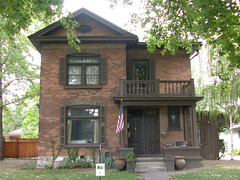
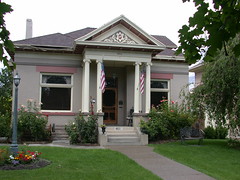



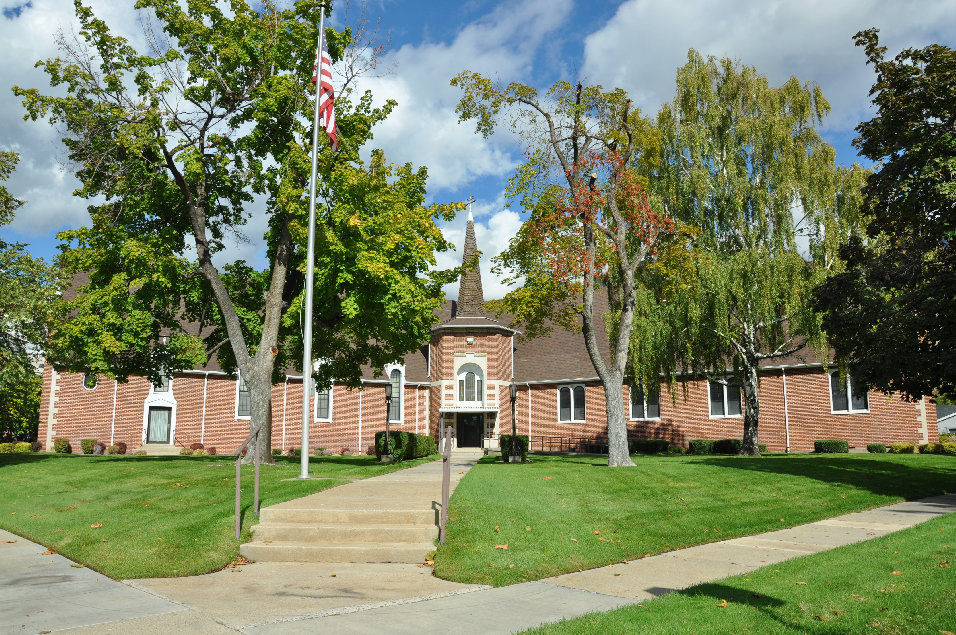


No comments:
Post a Comment